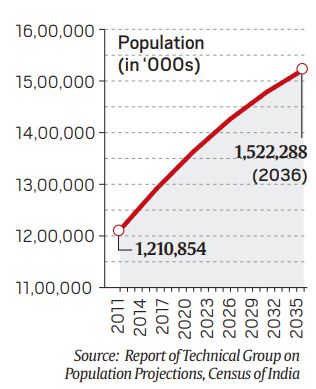
Primarily driven by increased life expectancy, changes in fertility rates, urbanisation, and migration, these factors are likely to have widespread implications for generations to come, impacting economic development, employment, income distribution, poverty, and social welfare.
Notably, with its population estimated to touch 142.86 crores, marginally ahead of China, India overtook China as the world’s most populous country, according to the UNFPA’s State of the World Population Report in 2023. This was a result of 11.1 million deaths and 9 million births in China, marking the second year in which China’s total population has been reduced.
The UNFPA report indicates that if India’s population continues to grow at the current rate of just under one per cent annually, it will double from its current value in the next 75 years. Experts say that India’s large population is a result of the “population momentum” from earlier decades and that the country’s population is likely to start its decline closer to 2050.
 Graph showing an increase in India’s population between 2011 and 2035.
Graph showing an increase in India’s population between 2011 and 2035.
This trend would also apply to the global population, which is currently slightly above 8 billion. However, it is expected that both India’s and the world’s populations will stabilise long before that.
Recognising the growth trends in population, the United Nations Development Programme (UNDP) emphasised the urgency of global population issues by establishing the Day of the Five Billion in 1987, which they have been observing as World Population Day on July 11th annually since 1990.
Story continues below this ad
 World Population Day seeks to raise awareness of global population issues. (Source: United Nations)
World Population Day seeks to raise awareness of global population issues. (Source: United Nations)
World Population Day serves as a platform to raise awareness and address crucial population-related challenges, in addition to highlighting the significance of family planning, gender equality, maternal health, and human rights.
This year, in 2024, it will fall on a Thursday and will emphasise the theme Investing in data collection is important to understanding problems, tailoring solutions, and driving progress.”
On World Population Day, we aim to raise awareness and understanding of global population issues, including demographic trends, growth projections, and their impact on sustainable development. Discover and take a look at the most populous countries in the world as of 2024.
Here are the top 10 most populated countries in the world, as of 2024:



 Graph showing an increase in India’s population between 2011 and 2035.
Graph showing an increase in India’s population between 2011 and 2035. World Population Day seeks to raise awareness of global population issues. (Source: United Nations)
World Population Day seeks to raise awareness of global population issues. (Source: United Nations)





























